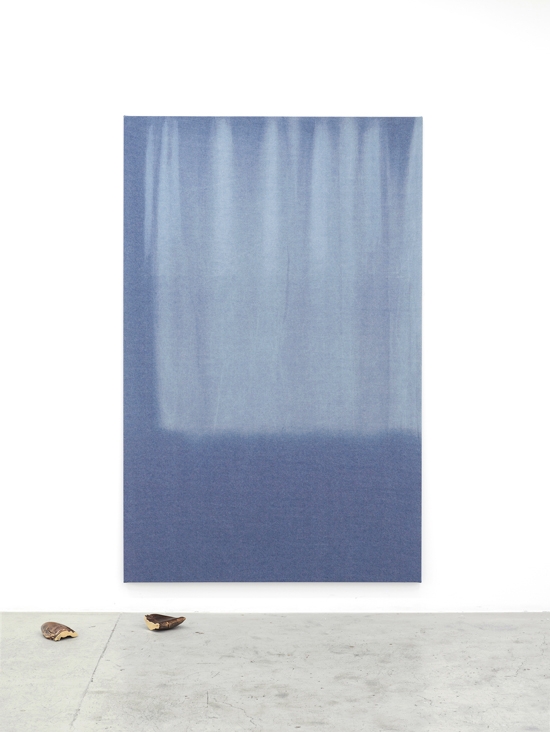I’m standing before a blue-grey canvas (Stills, 2014). Having just consulted the gallery text, I know that the canvas was originally a curtain. Further provenance is sketchy. It is simply described as having come from a ‘Milwaukee home’. Pulled taut over a stretcher, forced to become painting (in the high Modern sense, that is: a flat thing), the curtain reveals something distinguished. Years of exposure to sunlight have faded parts of its surface. One can trace the ghostly border of the window it once hung before and the undulating folds of its once relaxed state. Here – bleached in – is the pale light of the American north.
In his essay ‘The Libidinal Economy of the Dandy’ (1973), the philosopher Jean- François Lyotard writes of the exceptional light of the north European city in November, ‘all the buildings, all the objects, the faces, the cars, the trees, are ultimately exchangeable (chromatically) into blue-grey.’ Lyotard’s referent is of course Paris, but Stills (of which there are three identically titled similar versions in the exhibition) has me imagining instead the lucent ambience of Milwaukee in late autumn. All that desolate light draining the colour from the city. It could be depressing. But those of a northern manner (Marie Lund herself, a Dane, or her audience in London) perhaps take solace in the season’s turn; and note a certain lyricism to it all.
A negotiation between presence/absence underpins two further work groups in the exhibition. A suite of quadrilateral concrete sculptures cluster around the far righthand corner of the gallery (all Torso, 2014). Five in total, each features the trace of a thick-weave jumper that has been torn from the concrete following the casting process. Dotted around, a further set of sculptures (all Hand Full, 2014) see the negative space of Lund’s own blue-jean-pocket cast and transformed into five diminutive bronzes. Some of the pockets occupy lonely spots on the floor. Others perch on top of Torso blocks, their metal surface offering a visual foil to the concrete bases and their cosy anthropomorphic silhouettes.
Both the Hand Full and Torso series, while less profound when compared to the three Stills canvases, serve an important function within the exhibition as a whole. Lund’s wit is clearer in these sculptural works. They draw Dip back to a gainful interstice between earnestness and levity. It seems Lund is unwilling to allow herself to slip fully into the postminimal poetics of someone like Richard Tuttle (another textile obsessive). And for this I’m grateful. Her project is just a bit too wry for that lark. Indeed she would probably just shrug at my talk of Lyotardian blue-grey and the ‘lucent ambience’ of Milwaukee. Transcendence, if a concern at all for Lund, is to be located in the profane things of the world: curtains, jumpers, baby-blues…
This article was first published in the January & February 2015 issue.
